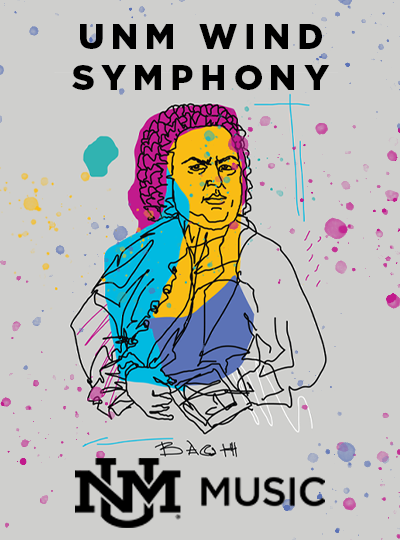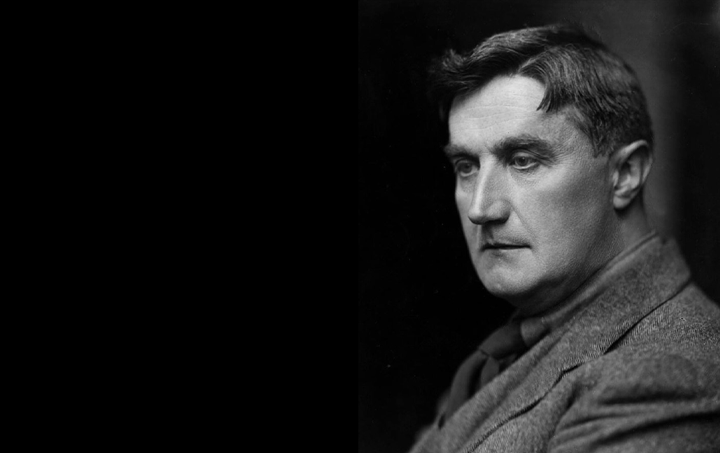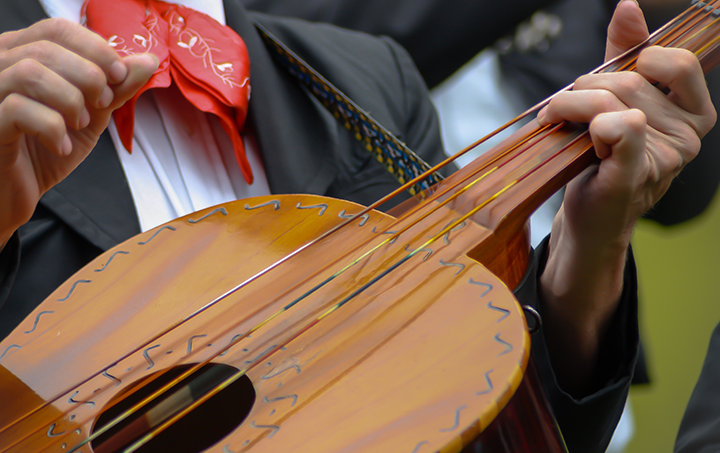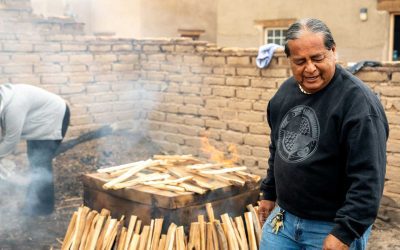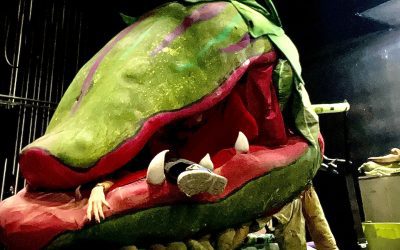
Celebrating art of mariachi during Hispanic Heritage Month & onward
UNM News Minute
It’s not just a song, an album or an artist. It’s not simply a genre, or something you hear walking through a plaza or a restaurant. It is so much more than music; it’s a history, it’s a culture, it’s a lifestyle.
Mariachi, associated with an image of a small, Mexican, musical ensemble is a passionate tradition that experts say shouldn’t have a concrete definition.
“Mariachi music is just so exciting! It has an interesting history in terms of how it became standardized, but it’s still not set or frozen in time. You know, early on mariachi might have had different instruments than you see today, but over time it changes,“ UNM Mariachi Ensemble Director Robert Lucero said.
Lucero, along with UNM Department of Music Post-Doctoral Fellow Adolfo Estrada, are two of the four instructors of the UNM Mariachi Ensemble. Each leads a different section through practice, performances and everything in between.
“All of the instructors bring their own wealth of experience and expertise on their particular instruments. We have one instructor for each section,” Lucero said. “To see the joy on the students’ faces as they’re performing and to see the reaction of the audience and how much the audience really loves mariachi music and the passion that the students put into it are my favorite things.”
A history worth 1,000 pages
Before understanding how each instrument, note and stylistic choice comes together at UNM, Estrada points to the past. While the word and origins are a tad murky, historians can agree mariachi began to make itself known in the mid-1800’s in west-central Mexico, right on the cusp of the Mexican Revolution.
“Mariachi music is a part of this huge son (song) complex that comes as a part of the colonial era to the new world and it takes on a life of its own, not just in Mexico, but throughout all of Latin America, ” Estrada said.
Mariachi began to get its well-earned popularity when city and rural centers collided after the revolution. Through the Mexican States of Colima, Jalisco, Michoacán, Nayarít and Guerrero, mariachi embodied the small chamber ensemble format of the baroque period, and Spanish poetic forms from the Old World. It was what Estrada calls the prototype form, or proto-mariachi ensemble.
“Mariachi music is not only a vibrant, social, lively music, it’s an art form, but it’s also a musical tradition that will follow you from the crib, all the way to you until our final resting place. I think that is part of its adaptability and dynamism. It’s about people coming together and having a motive to make those community bonds stronger through music making.” – Postdoctoral Fellow Adolfo Estrada
“The transformation they’ve undergone, I think, is really showing just how resilient the ensemble is. In terms of the urban centers having knowledge of these ensembles pre-Mexican Revolution, it was sparse. Those rural ensembles, of three to five musicians, typically would just include any type of instrumentation that was available. It wasn’t a choice of aesthetic at the time,” Estrada said.
Even then, there were differentiations in mariachi band elements, like in Michoacán’s conjuntos arpa grande, which showcased a baroque period-type harp in contrast to the Cocula region employing the guitarrón (large bass guitar) as the primary bass-producing instrument.
“All of the instruments are extremely flexible when it comes to interpretation and being able to perform many, many different genres,” Lucero said.
A sound of the times
Although rural mariachi ensembles were strictly string-based ensembles, mariachi’s sound got a distinct change once again, after relocating in major urban centers, like Mexico City in the mid-1930s.
“That’s when we start seeing different configurations, but we also see the music starting to homogenize. If you look at the recording catalog of commercial recordings, there’s obviously a period of long absence during the Mexican Revolution where no one’s recording, but then post-revolutionary Mexico, we see an increase in the size of the ensemble,” Estrada said. “The repertoire is greatly amplified. It begins to adopt a lot of different musical genres, other musical traditions, not only inside of Mexico, but outside of Mexico.”
The perfect storm of radio, recording artists and cine de oro (the Golden Age of Mexican Cinema) made the addition of the trumpet widely known.
“In the late 1920’s, once these mariachis started performing in live radio programs, there’s a mythology about who suggested that the trumpet be added, mostly attributed to Azcárraga Vidauerreta family dynasty of XEW powerful radio broadcast network, and now it’s emblematic of the mariachi. We can’t imagine a mariachi ensemble without a trumpet,” Estrada said.
From the earliest recordings of mariachi in 1907-1908, starring Cuarteto Coculense de Justo Villa, to the early radio broadcasts of Mariachi Coculense de Cirilo Marmolejo in the 1920’s, mariachi was not only on the map in parts of Mexico, but all of Latin America, and by the world.
“The first great mariachi migration was from the rural countryside into the city centers like Mexico City. The second one was its diffusion throughout all of Latin America. Anthropologist, Jesús Jáuregui argues that is when the mariachi starts becoming a national symbol, a musical symbol The third was the migration Mexican diaspora, which I consider myself a part of,” Estrada said.
Today, although mariachi ensembles continue to evolve, you will traditionally hear the following instruments: voices, trumpets, violins, vihuela, guitar, and guitarrón. The varying string instruments that make up the armonía (harmony) section–combine varying timbres and techniques to make a powerful, pleasing sound.
“So all of that comes together and makes this unique blend. The armonías drive the melodies like a rhythmic/harmonic engine giving mariachi music its unique sound,” Estrada said.
“The thing that I really enjoy about mariachi is that it’s able to interpret so many different genres. . . . and bring unique energy to each one of them.” – UNM Mariachi Ensemble Director Robert Lucero
Currently, you may also find vocals, harp, cajón, accordion, güiro, and choreography joining those traditional instruments and performance practices. Over the last century, different mariachi artists and groups took what once was a small quartet of guitars into innovative spaces, to whoever would listen.
“Mariachi music is performed in a lot of different contexts. In some, there’s a more traditional dichotomy between performer and audience,” Lucero said. “Then there are other contexts, for instance, at family gatherings, weddings, baptisms, funerals, birthdays where the people who hire the mariachi really want and expect to participate. It can be almost like a live karaoke gig, that’s one of the real joys about mariachi music –how it can really bring the community together.
The next generation of mariachi
Influence is a powerful thing in mariachi. Across generations, artists like Maestro Rubén Fuentes and José “Pepe” Martínez made an impact on Lucero and Estrada.
“My first exposure to the music in a live performance setting just really, I remember, left a very strong impression on me as a young man. I saw Mariachi Vargas perform for the first time live and I was blown away,” Estrada said. “I thought ‘that’s what I want to do for the rest of my life. I want to perform, play, and learn mariachi music. That’s what’s led me to the academic study of mariachi.”
Tracing back to the Mexican Revolution, through adversities up to the present pandemic, mariachi’s endurance is not just privy to the love it receives, but the people behind the sound.
“The other aspect is the will of the people who are behind the instruments. The musicians themselves are quite resilient. Mariachi has gone through its hardships as well. It’s gone through economic downturns,” Estrada said. “We’re not creating music in a vacuum, and so the resiliency of the music is a testament to the musicians and audiences nurturing the function that mariachi music has within our communities.”
“The fire within them about the art is what guides our instructors each day to pass on mariachi traditions at UNM,” Lucero said.
“You know, I’ve been playing since I was about 15, and it’s just a joy to be able to share it with the students who are in the mariachi class, the campus-wide community and the larger community around Albuquerque,” Lucero said.
Lucero says enrollment for the program and the separate mariachi student club are at a new record, thanks to the support of the College of Fine Arts. Although he has only been at UNM since 2019, he has already boosted mariachi interest, even though he had to teach classes online during COVID.
“UNM has had mariachi ensembles in the past, but when I got involved in 2019, it was virtually nonexistent. I was very thankful to have the support of the then Dean of Fine Arts and then chair of the School of the Department of Music, who were really excited about mariachi. Since then, that administrative and faculty support has continued,” Lucero said.
That includes the existence of a bolstered mariachi club, which functions outside of the class.
“Some students in the class may be learning about mariachi for the first time, and they don’t yet have as full a repertoire. I encourage them if they like it and they want to explore more, the club can be there for them to rehearse and perform more,” Lucero said.
That’s another thing that’s critical to understand about mariachi, during Hispanic Heritage Month and beyond; it’s not just for an audience, it belongs to them as much as it does the performers.
“I was told by Maestro José “Pepe” Martínez, ‘no es mío, es de ustedes– it’s not mine; it belongs to all of you.’ Now that more of these iconic figures have passed away, it’s kind of like a challenge, right?” Estrada said. “What are you going to do with it? How are you going to adapt to the world that you’ve inherited and then be a part of this musical tradition in a way that’s going to inspire others and continue its longevity and continue its success? I think one of the major things here is having mariachi ensembles in the university in higher ed and academic settings is that it’s able to now take on a different life.”
Throughout all of its iterations, mariachi has always been an engaging space for newbie and expert musicians, listeners and community members to participate.
“I think it’s just so satisfying to see the ensemble come together. You know, at the beginning we have students with various levels of experience with mariachi music. Some may have just heard it, some may have played for years,” Lucero said. “It’s always a challenge to find the right balance in terms of repertoire that’s challenging enough for the more experienced students, but not too advanced for less experienced students. I find that the students have really responded well to the challenge. By the end, when you see it come together, it’s just so rewarding.”
__
By Savannah Peat. Originally published on UNM News Minute. October 08, 2023
UNM News Minute. To read the full story please visit https://news.unm.edu/news/celebrating-the-art-of-mariachi-during-hispanic-heritage-month-and-onward?
Instagram: @unmmusic
Facebook: unmmusic
Confidence in Abstraction: Brandon Zech’s review of Raychael Stine’s “Falls and Springs and Stardust Things”
Brandon Zech of Glasstire: Texas Visual Art recently reviewed Professor of Painting and Drawing Raychael Stine’s exhibition, “Falls and Springs and Stardust Things,” in his piece “Chimerical Colors.” Zech writes, “Raychel Stine’s paintings are full of pleasurable...
Clarence Cruz Leaves a Lasting Native Pottery Legacy at UNM
Clarence Cruz, who is Tewa from Ohkay Owingeh (formerly San Juan Pueblo), serves as the Professor of Ceramics in the Art Department. He has been a prominent and familiar figure on campus since his student days.
UNM Students Feed the Fun in “Little Shop of Horrors”
UNM Theatre and Dance brings the cult-classic Little Shop of Horrors to the stage this season. Part B-movie spoof and part social satire, Little Shop of Horrors follows a meek and shy flower-shop worker whose discovery of a mysterious plant changes his life forever....



